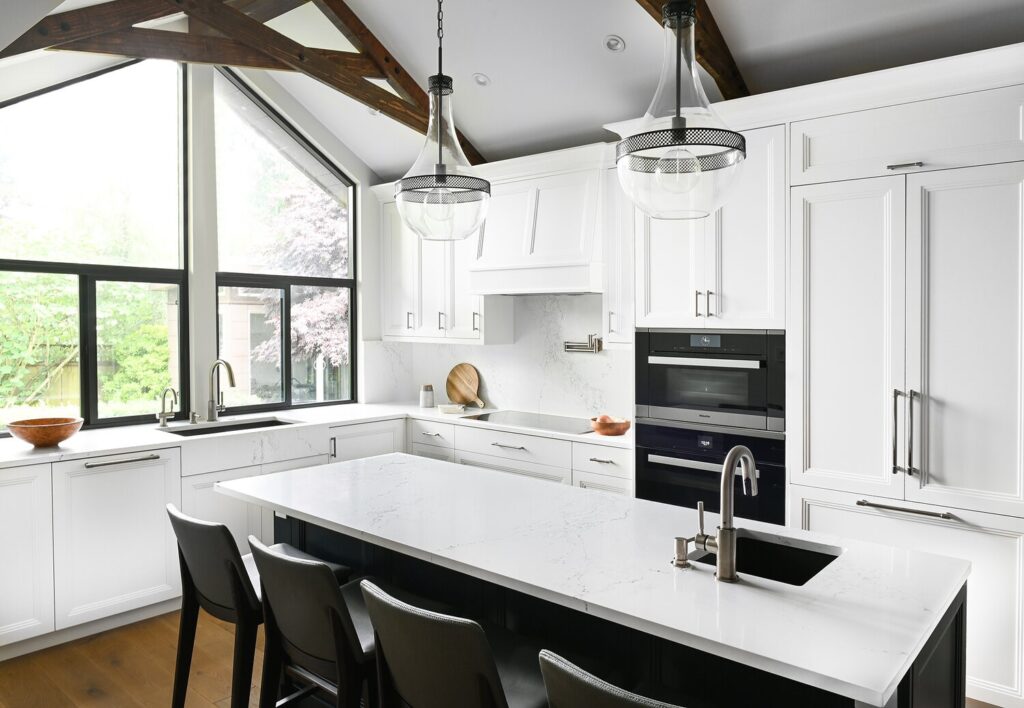- Photo: A 1980's Caulfield home completely renovated 35 years later to a high standard.
- Abstract: West Vancouver home inspector investigates source of high humidity levels.
Prior Water Ingress
Our homeowners have had their share of water related issues in the past. These have included:
- Water penetrating into the crawlspace.
- Water infiltration through exterior cladding.
- Ice dams forming during winter on the roof and backing up under the roof shingles.
- Leaky pipes under the kitchen sink.
All of the above were subsequently repaired. Yet there was still high humidity in the house. The owners showed us cabinets in the kitchen that were splitting at the joints that they thought might be from the swings in humidity between summer and winter, inside the house. They noted that the humidity was higher in the summer than the winter. The air conditioning is used throughout the summer and so a contractor checked out the coils in the evaporator for leaks or signs of icing… there were none.
Observations During Investigation
In the course of our investigation we discovered the follow deficiencies that should be addressed.
- The exhaust stack for the on-demand water heater required an additional 45 degree elbow to reduce the likelihood of rain or snow entering the stack.
- As well, at the water heater, the cold air supply duct was short and was drawing air from the closet itself rather than being piped in from the exterior. Since this was done by a qualified contractor, we could not argue with this installation. However, the owner needs to be aware that storage of flammable liquids in the garage (gas, oil based paints, solvents) may become hazardous if they vaporize and are drawn into the combustion chamber… expect explosive results!
- The insulated crawlspace opened into an uninsulated closet in the garage. We recommended closing off the closet from the crawlspace. to maintained a tempered crawlspace and warm floors above.
- There was a leak in the condensate line off the high efficiency furnace, creating water ponding around the base of the furnace. In addition, one section of the heating duct was not screwed together and the aluminum tape around the joint had fallen off creating a hot air leak.
- Water stains the crawlspace were observed; however, the stains tested dry with the moisture meter. This confirmed that prior remedial action had corrected the issue.
- The attic was checked for evidence of moisture damage such as roof sheathing discoloration, rusting roofing nails and water stains. No issues were noted. The attic and roof cavity were performing as they should.
- The windows were checked for condensation. None was observed.
Recommendations
Besides addressing some of the above issues, we could not find any obvious signs of where moisture could be introduced into the house. The owners have been meticulous with their renovations and proactive with scheduled maintenance as well as replacement of systems approaching the end of their service life.
In the final assessment, we were of the opinion that the high indoor humidity was not caused by moisture ingress; rather, it was cause by moisture generation and entrapment in the house that was not being vented out. Older houses are always leaky, because of the building methods of the time. New construction procedures make houses virtually air tight, to the extent that fresh outdoor air has to be introduced continuously with a fan that is always on. As well, an HRV (Heat Recovery Ventilator) is used to capture exhaust heat in the winter (or cold in the summer) and transfer it to the fresh air supply.
Our conclusion was that the recent renovation had created a house that was much more airtight than the original build. Therefore normal activities were creating moisture that could no longer leak out. We always consider the ‘no cost’ or ‘low cost’ solution first. Our recommendation was to crack a window open on the lower floor and to turn on a bathroom fan on the upper floor and let it run continuously. Yes this is a slight energy waster but if this improves the indoor air quality and occupant comfort, then it will be well worth it. In parting, we asked that the owners get back to us in a year’s time with their experience.

